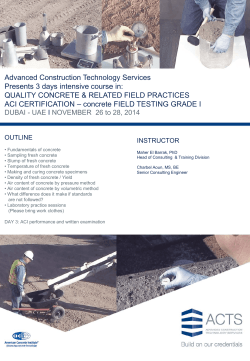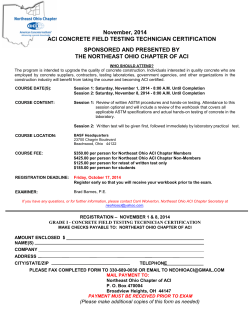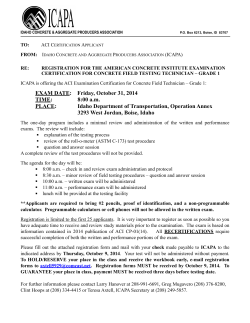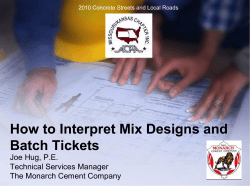
O ACI Documents on Formwork Maintain the Legacy
ACI Documents on Formwork Maintain the Legacy New publications include the 8th edition of ACI SP-4, Formwork for Concrete, which was unveiled at the ACI Fall 2014 Convention Description Basic requirements Formed concrete surface category CSC1 Concrete surfaces in areas with low visibility or of limited importance with regard to formed concrete surface requirements, used or covered with subsequent finish materials. Normal requirements ACI 347.3R-13, “Guide to Formed Concrete Surfaces,”1,2 is an entirely new document released in the spring of this year by ACI Committee 347, Formwork for Concrete. Chapters within ACI 347.3R describe formed surfaces, basics of layout and design, specification, construction, and evaluation of formed surfaces. The document’s primary function is to provide a detailed method for classifying formed concrete surfaces. Four levels of quality, called Concrete Surface Categories (CSC), are classified based on the visibility of the completed surface as well as the importance of its visual appearance (Table 1). For each CSC, qualities such as texture, surface void ratio, color uniformity, surface irregularities, and treatments of construction joints are defined. The guide also discusses phases of construction relating to concrete surfaces, from planning, selection of materials, and construction and repair procedures through the acceptance of a concrete surface. Ultimately, ACI 347.3R-13 can help the project owner, design team, contractor, formwork supplier, concrete supplier, and all other parties involved in the construction process in reaching a specific understanding of how a desired as-cast concrete surface can be defined and produced. Formed concrete surface categories, from Table 3.1a in ACI 347.3R-13 CSC2 Concrete surfaces where visual appearance is of moderate importance. CSC3 Concrete surfaces that are in public view or where appearance is important, such as exterior or interior exposed building elements. CSC4 Concrete surfaces where the exposed concrete is a prominent feature of the completed structure or visual appearance is important. Special requirements ACI 347.3R Table 1: Concrete surface finish with O ver the past year, ACI has published three documents that will assist in selecting, designing, and specifying formwork systems for concrete structures. The first of these releases was a new document intended to provide a means of better communicating the desired formed surface finish and quality between the engineer/architect and the contractor. The most recent releases are revisions of documents that have been staples in the formwork community for years. ACI 347R ACI 347R-14, “Guide to Formwork for Concrete,”3 presents the recommendations of ACI Committee 347 based on changes that have accumulated in the 10 years since the previous edition was published in 2004. By providing guidance regarding contract documents, selection of formwork, and use of formwork, the document serves as Concrete international NOVEMBER 2014 23 Fig. 1: ACI 347R contains design equations for calculating the lateral pressure of fresh concrete based on the concrete materials, properties, and placement rate a reference for design architects and engineers, formwork engineers, and contractors. For easy reference, the document lists items that should be indicated in the contract documents by the engineer/ architect. Examples include materials and accessories; finishes; design, inspection, and approval responsibilities; and any requirements that would restrict the selection, design, or layout of the formwork. Many of these recommendations can help achieve economy of the structure through formwork economy. ACI 347R-14 also contains recommendations for the formwork engineer that will design the formwork and select the components. The recommendations cover topics such as loads, factors of safety, and shoring and bracing. The design recommendations for concrete lateral pressure (Fig. 1) have been revised to a tabular presentation for a more direct understanding, and the provisions for wind load magnitudes and minimums have been clarified. The chapter on materials has been revised to reflect the changes in many material design specifications and standards used in formwork. For the contractor, recommendations for the safe and economical construction, stripping, shoring, and reshoring of formwork are presented in the chapter on construction. The information has been generally updated to reflect current safety precautions, construction practices, workmanship, tolerances, shoring, reshoring, inspection, and stripping of formwork. Additional information that can be helpful for all parties includes chapters on architectural concrete, special structures, 24 NOVEMBER 2014 Concrete international Fig. 2: Mary K. Hurd, author of the first seven editions of Formwork for Concrete, touring a construction site in October 2004, with Eric Peterson, current Chair of ACI Committee 117, Tolerances. In recognition of Hurd’s tremendous contributions in creating and maintaining SP-4, the eighth edition is dedicated to her memory and achievements and special construction methods. These have been generally revised to reflect current practice. SP-4, Formwork for Concrete The eighth edition of ACI SP-4 Formwork for Concrete4 was released in October 2014. In the five decades since Formwork for Concrete made its first appearance in 1963, more than 130,000 copies have been printed, and the manual has become recognized as the “green bible” of the formwork industry. Formwork for Concrete has been and continues to be a cooperative effort supported by individuals, companies, public agencies, and industry and professional associations. In large measure, this is due to the groundwork laid and respect for Formwork for Concrete garnered through the pioneering efforts of Mary K. Hurd (Fig. 2), the original author. As a young staff engineer at ACI, Mary Hurd was tasked with coordinating the development of a manual for the formwork industry with ACI Committee 347. This was certainly a daunting assignment for a young female engineer in the 1960s. Her commitment to the project and production of an excellent resource would be recognized over the next 50 years by her being asked to revise and update the document six times. This continued even after she had left ACI to pursue other opportunities. Although the document has grown significantly over the years, even the first edition provided significant coverage of the major topics related to formwork design and construction, as shown by the chapter titles from the Table of Contents for the first edition (Fig. 3). With the exception of combining the Precast Concrete and Prestressed Concrete chapters into the chapter on Special Techniques in Concrete Construction, this chapter layout would remain unchanged for the subsequent six editions. David W. Johnston, a member and past Chair of ACI Committee 347, was tasked to revise and update the new edition. The eighth edition, as all previous editions, follows the most recent guidelines established by ACI Committee 347 and documented in the committee report, now ACI 347R-14, which is reprinted in full in the appendix. This new edition of Formwork for Concrete considers the updated lateral pressure and other provisions now provided by ACI 347R. Expanded coverage is included in SP-4 for wind loads on formwork specialized from ASCE/SEI 7-105 as modified by ASCE/SEI 37-14.6 Analysis of the shoring and reshoring process and evaluation of concrete and structure strength to withstand shoring loads have been consolidated in a new chapter. As shown by the chapter titles in the Table of Contents for the eighth edition (Fig. 4), design of formwork has been divided into two chapters, one focusing on bending, shear, and deflection of wall, slab, and column formwork members, and a second focusing on shoring and bracing members. Bridge formwork considerations have been moved into a separate chapter. A new chapter summarizing the recommendations of ACI 347.3R on formed concrete surfaces has been added. This edition also reflects the latest changes in wood design recommendations of the American Wood Council and introduces load and resistance factor design (LRFD) for wood formwork members in addition to the primary coverage based on allowable stress design (ASD) procedures. The recent recommendations of other ACI committees have also been considered in the manual revisions and some related provisions of ACI 318-117 and the Occupational Safety and Health Administration8 have been extracted for convenient reference in the appendix. The growing number CHAPTER 1: INTRODUCTION CHAPTER 1: INTRODUCTION CHAPTER 2: GENERAL OBJECTIVES IN FORMWORK BUILDING CHAPTER 2: GENERAL OBJECTIVES IN FORMWORK BUILDING CHAPTER 3: OVER-ALL PLANNING FOR FORMWORK CHAPTER 3: OVERALL PLANNING CHAPTER 4: MATERIALS, ACCESSORIES, PROPRIETARY PRODUCTS CHAPTER 4: MATERIALS, ACCESSORIES, PROPRIETARY PRODUCTS CHAPTER 5: LOADS AND PRESSURES CHAPTER 5: LOADS AND PRESSURES CHAPTER 6: FORM DESIGN CHAPTER 6: SHORING AND FLOOR LOADS IN MULTI-STORY STRUCTURES CHAPTER 7: DESIGN TABLES CHAPTER 7: DESIGN OF SLAB, WALL, BEAM, AND COLUMN FORMS CHAPTER 8: FORMWORK DRAWINGS CHAPTER 8: DESIGN OF FORM SHORES AND BRACING CHAPTER 9: BUILDING AND ERECTING THE FORMWORK CHAPTER 9: DESIGN TABLES CHAPTER 10: USING THE FORMS CHAPTER 10: FORMWORK DRAWINGS CHAPTER 11: FORMWORK FOR ARCHITECTURAL CONCRETE CHAPTER 11: BUILDING AND ERECTING THE FORMWORK CHAPTER 12: SHELL, DOMES, FOLDED PLATES CHAPTER 12: USING THE FORMS CHAPTER 13: MASS CONCRETE CHAPTER 13: FORMED CONCRETE SURFACE QUALITY CHAPTER 14: TUNNELS AND SHAFTS CHAPTER 14: FORMWORK FOR ARCHITECTURAL CONCRETE CHAPTER 15: SPECIAL TECHNIQUES IN CONCRETE CONSTRUCTION CHAPTER 15: BRIDGE FORMWORK CHAPTER 16: PRECAST CONCRETE CHAPTER 16: MASS CONCRETE FORMWORK CHAPTER 17: PRESTRESSED CONCRETE CHAPTER 17: TUNNEL AND SHAFT FORMWORK ACKNOWLEDGMENTS CHAPTER 18: SPECIAL TECHNIQUES IN CONCRETE CONSTRUCTION APPENDIX APPENDIX Fig. 3: Chapter titles from the Table of Contents for the first edition of Formwork for Concrete demonstrates the breadth of topics covered Fig. 4: Chapter titles from the Table of Contents for the eighth edition of SP-4 Concrete international NOVEMBER 2014 25 Fig. 5: As part of bringing the eighth edition of Formwork for Concrete up to date, nearly 500 modern color photographs were included. Color was added to over 150 illustrations to improve clarity and understanding of standards related to design of the construction process and design of temporary structures, as well as a number of formwork industry products and practices adopted since the last edition was published, have been considered during development of the revisions. Throughout the process, efforts were made to provide a consistent set of notation within SP-4 while maintaining consistency when possible with the standards of the multiple organizations referenced. The extensive glossary of terms has been updated to reflect the latest changes in ACI 347R and ACI Concrete Terminology.9 While most of the SP-4 manuals are used in design and construction firms, initially half are used by students in civil engineering, construction engineering, architectural engineering, engineering technology, and construction management university curriculums. Later, those copies follow the graduates into industry use as well. The reorganization and separation of the design content into multiple chapters is intended to make the material more digestible for both student and industry users. For instructional use, a series of problems and review questions have been provided following the appendix. Revising and bringing an iconic document up to date included reference to the latest design standards, design methods, procedures, products, and both revised and new worked examples. Nearly 500 modern color photographs were selected to enable the eighth edition of Formwork for Concrete to be the first edition in full color (Fig. 5). The assistance of the many individuals and formwork and construction companies that permitted the use of their photographs and illustrations allows Formwork for Concrete to show a breadth of formwork application that would not be possible otherwise. This broad coverage is one of the characteristics that has made Formwork for Concrete one of ACI’s best-selling documents. Members of ACI Committee 347 were engaged by the author during the process of revising the document, as they have been during the development of previous editions. 26 NOVEMBER 2014 Concrete international Their comments and insight have brought a balanced viewpoint to the document that is not found in other documents on the topic. Members of the ACI Educational Activities Committee (EAC), with the assistance of outside reviewers selected from ACI Committee 347, provided final review comments for chapters of the document. Responses by the author to these comments were reviewed and approved by the EAC members who commented on the chapter. These comments provide a fresh perspective and helped ensure that people reading the document for the first time would be able to quickly and easily understand the content. These reviewers also made sure that the content of this work was consistent with other ACI documents. These suggestions have helped improve the document for the final end user. More to Come ACI Committee 347 is currently revising ACI 347.2R-05, “Guide for Shoring/Reshoring of Concrete Multistory Buildings,” another committee document that is discussed extensively in the eighth edition of Formwork for Concrete. In addition, the committee is developing a new design specification for formwork. These two documents and changes in the industry over the intervening years will provide significant material when it comes time for Formwork for Concrete to enter its ninth edition. References 1. ACI Committee 347, “Guide to Formed Concrete Surfaces (ACI 347.3R-13),” American Concrete Institute, Farmington Hills, MI, 2013, 17 pp. 2. Spahr, R., and Johnston, D.W., “The New ‘Guide to Formed Concrete Surfaces’,” Concrete International, June 2014, pp. 31-32. 3. ACI Committee 347, “Guide to Formwork for Concrete (ACI 347R-14),” American Concrete Institute, Farmington Hills, MI, 2014, 36 pp. 4. Johnston, D.W., Formwork for Concrete, SP-4, eighth edition, American Concrete Institute, Farmington Hills, MI, 2014, 512 pp. 5. “Minimum Design Loads for Buildings and Other Structures (ASCE/SEI 7-10),” American Society of Civil Engineers, Reston, VA, 2013, 636 pp. 6. “Design Loads on Structures During Construction (ASCE/ SEI 37-14),” American Society of Civil Engineers, Reston, VA, 2014 (in process). 7. ACI Committee 318, “Building Code Requirements for Structural Concrete (ACI 318-11) and Commentary,” American Concrete Institute, Farmington Hills, MI, 2011, 503 pp. 8. Occupational Safety and Health Administration, “Safety and Health Regulations for Construction (OSHA 29 CFR 1926), United States Department of Labor, Washington, DC. 9. “ACI Concrete Terminology,” American Concrete Institute, Farmington Hills, MI, 2014, http://terminology.concrete.org. (last accessed Sept. 1, 2014) Selected for reader interest by the editors.
© Copyright 2025











